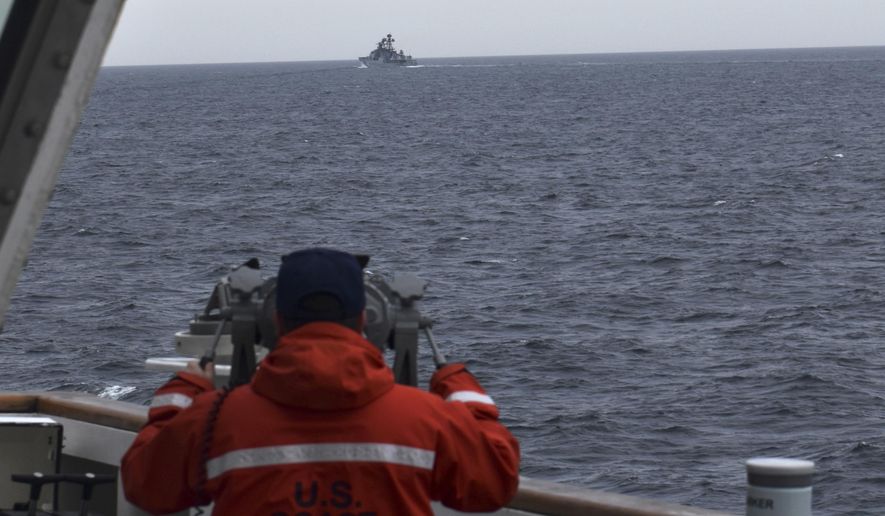Chinese and Russian warships conducted a joint patrol near Alaska last week and prompted a Coast Guard cutter and C-130 transport to monitor the ship movements, Coast Guard officials have revealed.
The first Chinese ship spotted was the guided-missile cruiser Renhai and was about 75 miles north of Kiska Island, at the far western end of the Aleutians in the Bering Sea.
Two other Chinese naval vessels and four Russian navy ships were also part of the joint Chinese-Russian convoy that sailed in a single formation, according to a statement put out Monday by the Coast Guard.
The joint naval operation is the latest sign of growing military cooperation between Beijing and Moscow, even as both face growing tensions with the U.S. and its allies. Both militaries took part in recent large-scale war games in the Russian Far East known as Vostok 2022, which included naval operations near Japan.
The Renhai sailed within the U.S. exclusive economic zone (EEZ) and as a result the Coast Guard carried out an operation called Operation Frontier Sentinel. The operation uses Coast Guard ships from the 17th District to mobilize “when strategic competitors operate in and around U.S. waters,” the statement.
“While the [Chinese-Russian] surface action group was temporary in nature, and the Kimball observed it disperse, the Kimball will continue to monitor activities in the U.S. EEZ to ensure the safety of U.S. vessels and international commerce in the area.”
SEE ALSO: Pentagon establishes new senior coordinator for Arctic policy
A Coast Guard C-130 transport also took part in monitoring the warships.
“While the formation has operated in accordance with international rules and norms, we will meet presence with presence to ensure there are no disruptions to U.S. interests in the maritime environment around Alaska,” said Rear Adm. Nathan Moore, commander of the Coast Guard district.
It was the second year in a row that Chinese warships sailed into U.S.-monitored waters near Alaska. A year ago, Coast Guard cutters were deployed to monitor four Chinese warships that were part of a surface action group sailing about 50 miles off the Aleutians.
The task force included a guided-missile cruiser, a guided-missile destroyer, an intelligence-gathering ship known as an AGI, and an auxiliary ship.
Air Force Gen. Glen D. VanHerck, commander of the Northern Command and head of the U.S.-Canadian North American Aerospace Defense (NORAD) Command, said in July that China is engaged in “aggressive” reconnaissance activities in the Pacific, noting the task force near the Aleutians from Aug. 29 to Sept. 1, 2021.
Those warships also sailed into the American exclusive economic zone but remained outside U.S. territorial waters during that expedition.
A Northern Command spokesman said the Chinese and Russian naval operation last week was closely watched.
The spokesman added that “we routinely track and monitor foreign military vessels operating in the U.S. Northcom [area of responsibility] as part of our integrated homeland defense of the United States.”
Foreign nations’ interest in the Arctic is expected to lead to more such warship visits in the future, the spokesman said.
The naval action last year followed a report in the regime-affiliated Global Times that said China’s military dispatched the warships near U.S. territory in response to Navy “freedom of navigation” operations in the South China Sea. Those operations are designed to challenge aggressive sovereignty claims by Beijing to the South China Sea, one of the busiest commercial waterways in the world.
Gen. VanHerck also said China is also seeking to gain control of areas of the Arctic and has sent an icebreaker to North America.
“Each of the last six years the Xue Long, the research ship that they talk about, has sailed into the [U.S. Northern Command area of responsibility] and into the Arctic under the guise of doing scientific research,” he said. The Chinese “are also doing military studies, mapping the seabed for potential submarine operations.”
Kiska Island was historically one of only two locations where Japanese forces invaded and held American soil during World War II. On June 6, 1942, 500 Japanese marines went ashore on Kiska Island and took over a Navy weather detachment of 10 men. A day later, the Japanese captured nearby Attu Island.
It was the first time U.S. territory had been lost to a foreign adversary since the War of 1812.
A U.S. invasion force attacked Kiska Island in August 1943 but found it abandoned by the Japanese.
Earlier this month, on Sept. 11, Russia conducted military reconnaissance flights by two Tu-142 maritime patrol aircraft near Alaska. The Russian aircraft were intercepted by two F-22 and two CF-18 jets.
• Bill Gertz can be reached at bgertz@washingtontimes.com.




Please read our comment policy before commenting.